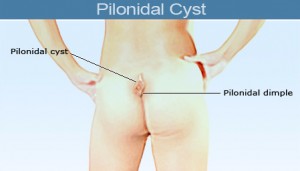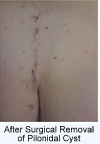What is a Pilonidal Cyst?
A Pilonidal Cyst is a cyst that develops in the midline of the tailbone near the cleft of the buttocks. The most accepted theory for the cause of these cysts is the blockage of hair follicles in the skin of the area which creates “pits” in the cleft of the buttocks. As the follicles become clogged with hair and skin debris, cyst formation occurs. 
Individuals with Pilonidal Cysts may not have any symptoms at all, where in others the cyst may become infected with skin bacteria resulting in inflammation and pain. As the infection progresses the cyst may grow and rupture into the surrounding tissue, forming an abscess . Infected Pilonidal Cysts/Abscesses can cause severe pain, redness, swelling, and warmth of the skin of the tailbone area. In cases of abscesses there may be drainage of pus from an opening in the cyst. Fever may also be associated with the condition.
Who gets Pilonidal Cysts?
Pilonidal Cysts occurs most commonly in young adults, mainly between the ages of 15-24. It is very rare for anyone to develop Pilonidal disease after the age of 40. Males are more likely to develop these cysts than females.
Treatment of Pilonidal Cysts
Pilonidal Cyst treatment depends on the degree of symptoms and the extent of the disease present. Acutely infected cysts or abscesses require prompt incision and drainage for improvement. In this procedure an incision is made over the area of infection under local anesthesia. The pus is drained and the hair and skin debris are removed from the cyst cavity. The cyst itself is not removed at this stage. The wound is left open and packed with gauze. Wound healing occurs over the course of 4 to 8 weeks.
The above treatment is only a temporizing treatment, and recurrence of Pilonidal Cysts or repeated infections are common. For this reason, definitive treatment requires full surgical removal of the entire cyst and its contents. This is performed under elective conditions using general anesthesia at a time when the cyst is free of infection.

There are various surgical options when it comes to Pilonidal Cyst excision. However all patients should be informed that the post-operative course following cyst removal can be a long and difficult one. Following surgical treatment the patient may be left with a chronically draining open wound for months or even years. Weekly office appointments may be needed for further removal of hair and debris from the wound. Every patient should also be educated about the importance of maintaining strict hygiene in the area with regular washing and shaving to keep the wound clean and free of hair.
Though many patients are completely cured following surgical removal of their Pilonidal Cysts, even after surgery recurrence of these cysts are possible. That is why the proper aftercare of the surgical wound plays such a crucial role in achieving a successful outcome.
Dr. Zadeh uses a special technique for Pilonidal Cyst Surgery which results in very low rates of wound complications and recurrence. If you think you may have a pilonidal cyst feel free to call our office at (818) 789-1111 with any questions or to schedule a consultation.

